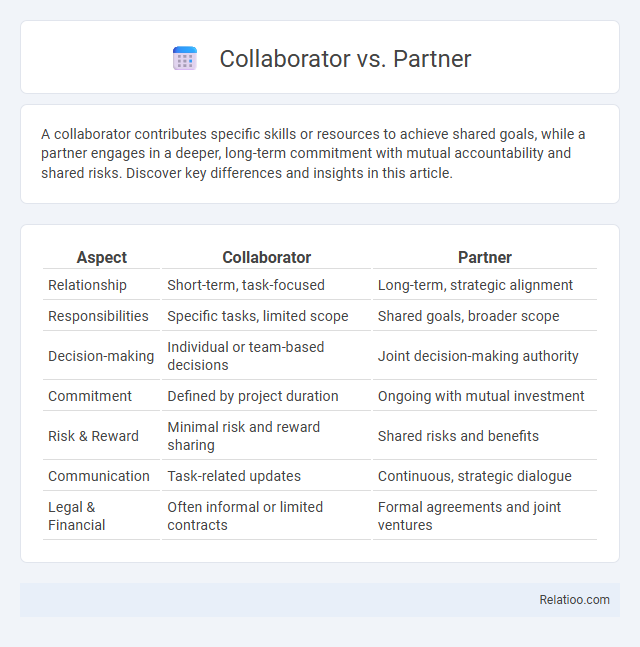A collaborator contributes specific skills or resources to achieve shared goals, while a partner engages in a deeper, long-term commitment with mutual accountability and shared risks. Discover key differences and insights in this article.
Table of Comparison
| Aspect | Collaborator | Partner |
|---|---|---|
| Relationship | Short-term, task-focused | Long-term, strategic alignment |
| Responsibilities | Specific tasks, limited scope | Shared goals, broader scope |
| Decision-making | Individual or team-based decisions | Joint decision-making authority |
| Commitment | Defined by project duration | Ongoing with mutual investment |
| Risk & Reward | Minimal risk and reward sharing | Shared risks and benefits |
| Communication | Task-related updates | Continuous, strategic dialogue |
| Legal & Financial | Often informal or limited contracts | Formal agreements and joint ventures |
Understanding the Definitions: Collaborator vs Partner
A collaborator refers to an individual or organization working jointly on a project or task, often contributing specific expertise without necessarily sharing ownership or long-term commitment. A partner implies a deeper relationship involving shared responsibilities, risks, profits, and decision-making authority, commonly formalized through legal agreements or contracts. Understanding the definitions clarifies that collaboration emphasizes cooperation and shared effort, while partnership denotes a strategic alliance with mutual accountability and investment.
Key Differences Between Collaborators and Partners
Collaborators work together on specific tasks or projects without sharing long-term commitments or risks, while partners engage in a deeper, more strategic relationship involving shared profits, liabilities, and decision-making. Your choice between collaborators and partners depends on the level of involvement, trust, and resource sharing required for your business goals. Understanding these distinctions helps optimize teamwork and align expectations for successful outcomes.
Roles and Responsibilities in Each Relationship
Collaborators typically contribute specialized skills or resources to a project with specific, defined tasks, while partners share equal stakes in decision-making, profits, and risks, fostering a long-term commitment to mutual goals. In a partnership, responsibilities often include joint strategy development, financial investment, and shared accountability, contrasting with collaborators whose roles are more task-oriented and limited in scope. Understanding these distinctions ensures clarity in roles, facilitates effective communication, and aligns expectations for successful cooperation.
Levels of Commitment and Involvement
Collaborators typically engage in short-term or project-specific tasks with limited commitment and involvement, focusing on shared goals without deep integration. Partners demonstrate a higher level of commitment through long-term alliances, resource sharing, and strategic alignment, often involving joint decision-making and shared risks. Strategic alliances involve complex, multi-layered collaboration with extensive integration, mutual dependency, and significant investment in combined operations and innovation efforts.
Legal and Contractual Considerations
In legal and contractual contexts, a collaborator typically engages in joint efforts without forming a binding partnership, often operating under specific collaboration agreements that outline roles and intellectual property rights. A partner implies a formal legal relationship governed by partnership laws, sharing profits, liabilities, and decision-making responsibilities equally or as stipulated in the partnership agreement. Understanding the distinctions ensures appropriate contract structuring, liability allocation, and clarity on ownership and governance in joint ventures or business arrangements.
Impact on Business Outcomes
Collaborators contribute specific skills or resources to a project without long-term commitments, which can enhance your business outcomes by providing targeted expertise quickly. Partners engage in deeper, strategic relationships with shared goals and risks, driving sustainable growth and innovation that significantly impact business success. Unlike collaborators and partners, alliances combine strengths across organizations to expand market reach and create competitive advantages, amplifying overall business performance.
Trust and Communication Dynamics
Trust forms the foundation of effective collaboration, with partners typically sharing deeper mutual commitments and aligned goals compared to collaborators who may engage more task-oriented interactions. Communication dynamics in partnerships emphasize ongoing transparency, open dialogue, and joint decision-making, fostering stronger relational bonds. Collaborators often rely on clear, project-specific exchanges, while partners invest in building long-term trust through consistent, meaningful communication and shared accountability.
Choosing the Right Relationship for Your Goals
Choosing the right relationship for your goals depends on understanding the distinctions between collaborators, partners, and affiliates. Collaborators typically work together on specific projects with shared expertise but limited commitment, while partners share a deeper, often long-term investment in the business's success and risks. Affiliates usually promote products or services for commissions, offering less direct involvement but valuable outreach to expand your brand's reach.
Real-World Examples of Collaborators and Partners
Collaborators and partners play distinct roles in business ecosystems, with collaborators typically engaging in project-based efforts while partners establish longer-term strategic alliances. Real-world examples of collaborators include freelance graphic designers or marketing agencies hired on a contract basis to contribute specific expertise, whereas partners can be seen in companies like Starbucks and PepsiCo, which formed a partnership to distribute bottled coffee beverages. Understanding these differences helps organizations optimize resource allocation and achieve targeted goals through either short-term collaboration or enduring partnerships.
Best Practices for Building Successful Relationships
Building successful relationships requires clear communication, mutual respect, and aligned goals between collaborators and partners. You should establish defined roles and responsibilities to ensure accountability and foster trust. Regular feedback and shared commitment to objectives enhance collaboration effectiveness and long-term partnership success.

Infographic: Collaborator vs Partner
 relatioo.com
relatioo.com